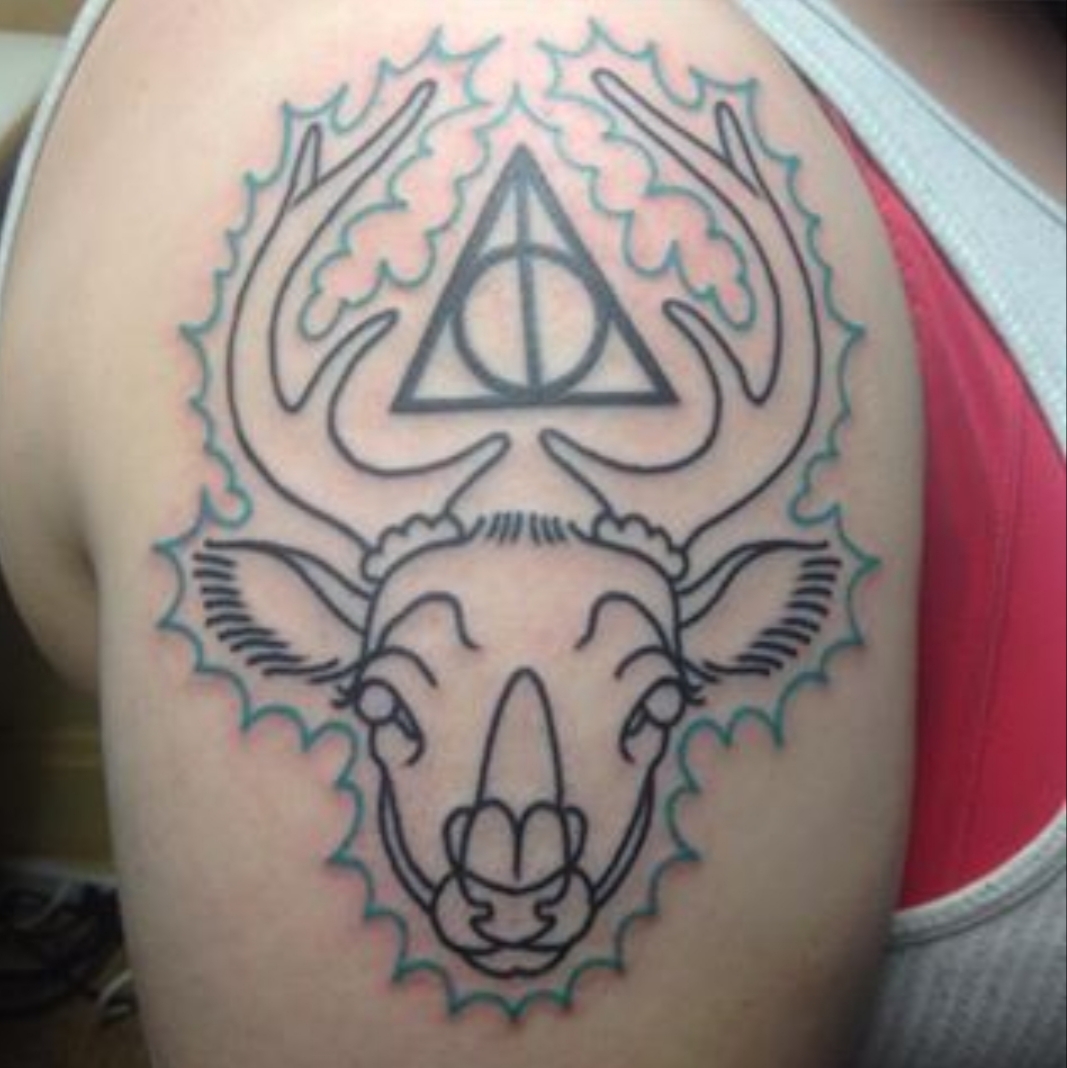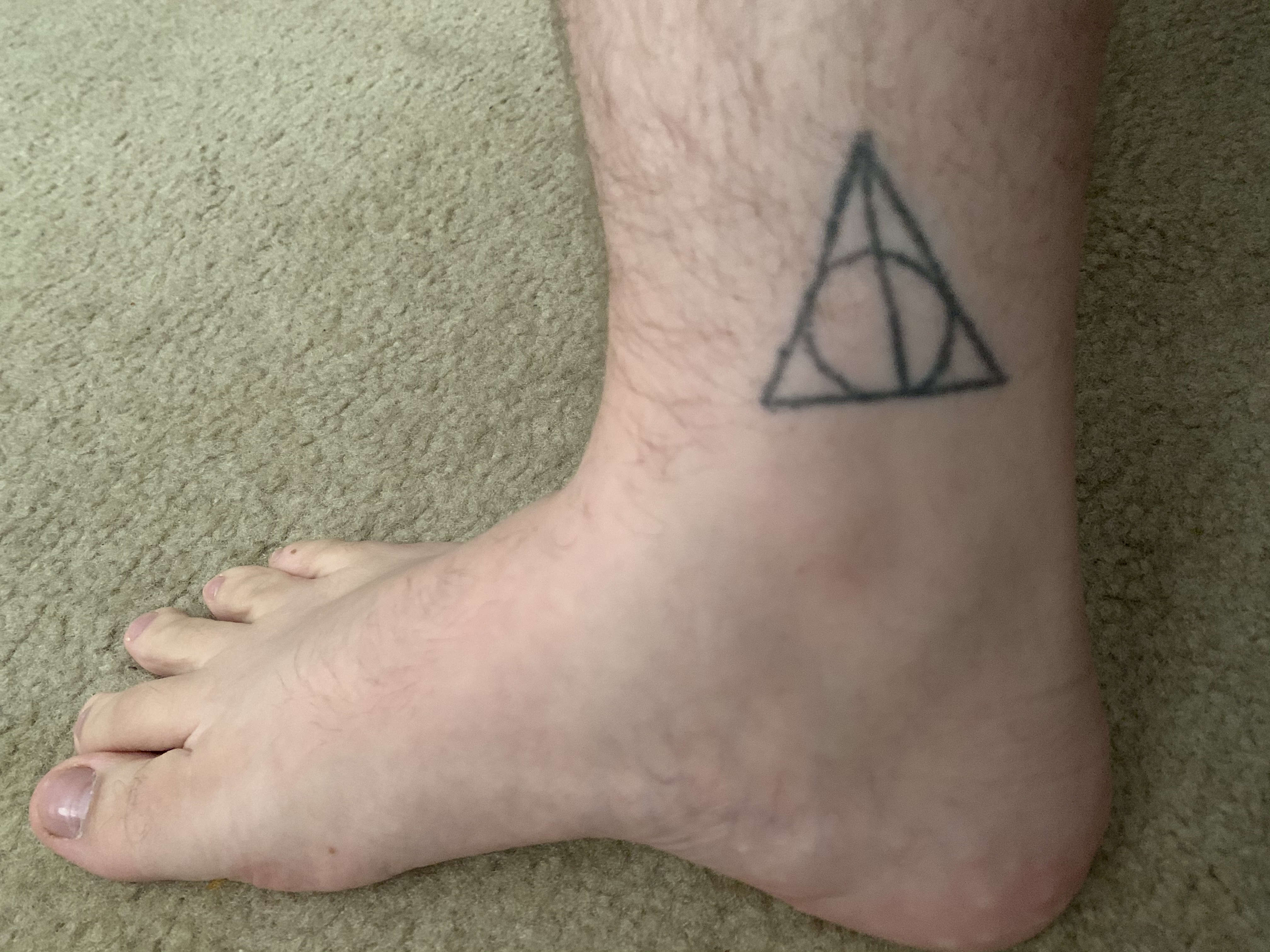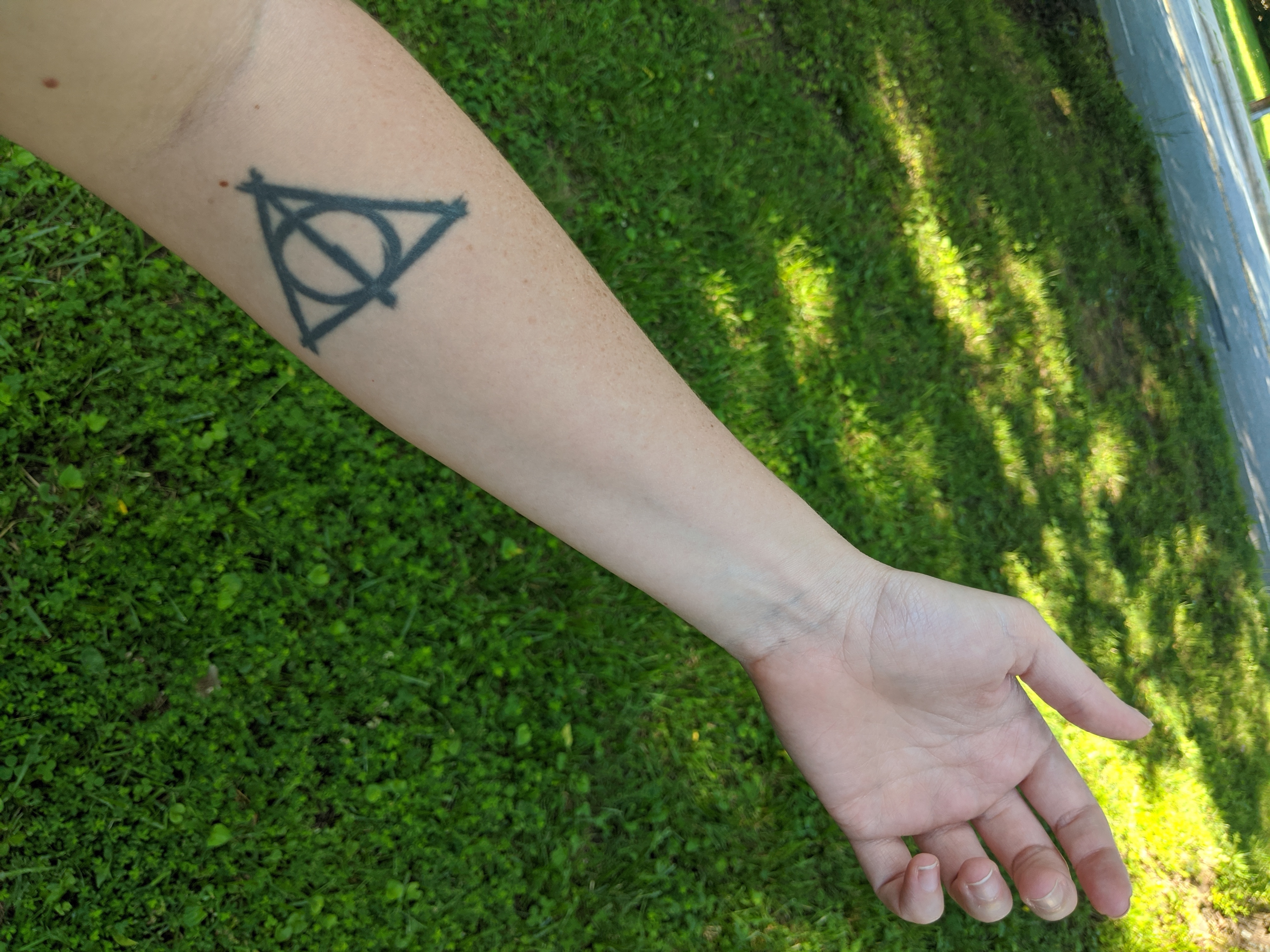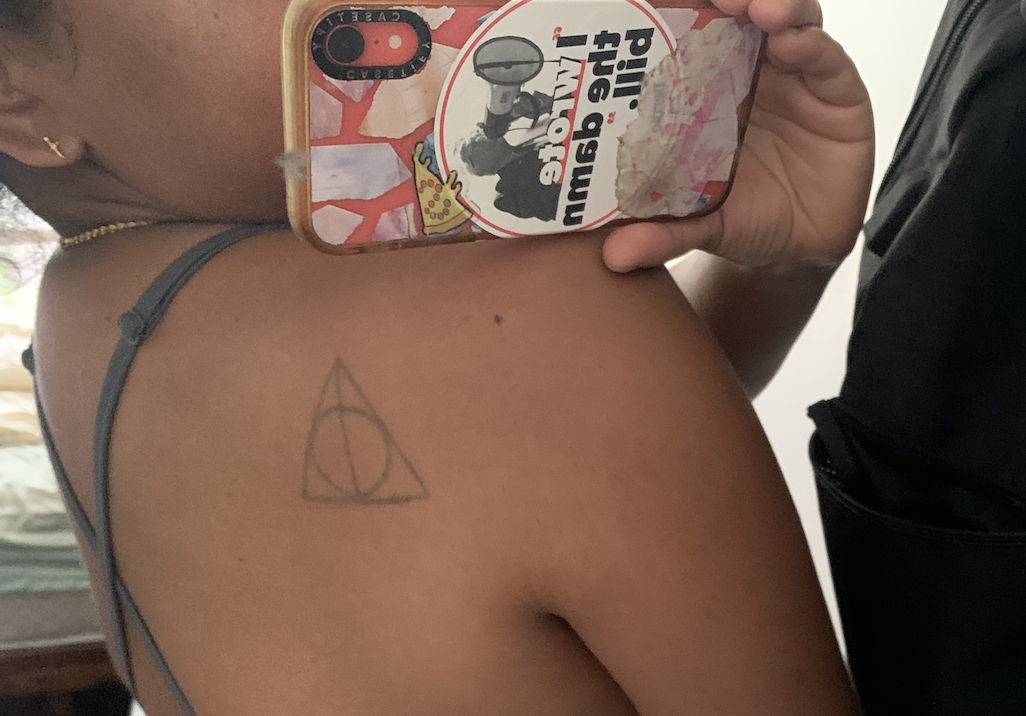By the time Harry Potter author JK Rowling had written a 4,000 word essay describing her bigoted views on trans people on June 10, she was already on thin ice. After years of post-textual additions to the series and veiled transphobia elsewhere in her oeuvre, being a Harry Potter fan had become tedious and tiresome. I had already been considering covering up my small tattoo of the deathly hallows symbol, but for me, the June 10 essay cemented it. My relationship to Harry Potter as an adult was already conflicted; now I simply cannot wait to have the marker of my fandom removed from my body. Even the news of an upcoming Harry Potter video game, something I've wanted for years, no longer brings me any joy.
I'm not the only fan who feels this way. There have been viral tweets from others who want to get their Harry Potter tattoos covered up. Artist Molly Ostertag offered to help some fans design their cover ups in return for a donation to a charity for trans women of color.
Three fans spoke with Motherboard about their own Harry Potter tattoos, and their plans to cover them up.
Laney
Laney's tattoo combined the symbol of the deathly hallows, which in the books signals to other people that you're on a similar, specific quest, and a stag, which is Harry's patronus, which protects him from creatures that feed on fear.
"This tattoo started as just a deathly hallows on my shoulder, back in 2011," Laney said. "I was fully on the hype train for the Harry Potter fandom on Tumblr. I was swept up, especially in the movie series ending. I was like, I want to put this on my body forever."
Laney said that she planned on adding more to the tattoo. Now, she's not sure about how she'd go about it.

"As I've gotten more critical in my adult years, it's been kind of weird going back," she continued. "It's very, very strange now to have this downward spiral of understanding JK Rowling as an author and also the work as it stands on its own."
There's plenty that's side-eye worthy in Rowling's original text. The goblin bankers of Gringotts are described as greedy, hook nosed creatures that control the Wizarding World's banks, which is antisemtitic even if it was accidental. The series' treatment of non-white characters like Parvati Patel, Dean Thomas, and Cho Chang, who is named Cho Chang, has never been stellar. Laney first started considering getting a cover up for her tattoo when the post-textual additions to Harry Potter started verging from welcome to outright weird.
The first time Rowling added to her text after it was published, it was to reveal that Dumbledore was gay. At the time Laney had been excited by that news.
"I was still in the closet then. That was one of those where I was like, 'Oh my God. It's so cool that she did this.'" Laney said. "Like I was all about it. I was very into it, mostly cause I hadn't really sat with how it felt about my own queerness."
But that immediate joy at Rowling revisiting Harry Potter would not last. In fact, it would get much worse.
"The one that really made me start going 'okay, hun' was when she started talking about the schools from around the world," Laney said. This information is on Pottermore, Rowling's online encyclopedia of Harry Potter knowledge. "That was the one real like, monkey's paw moment for me, where I was wishing for more content. That doesn't mean that the content is good."
Beyond having just one school for the entire continent of Africa, and her lack of clarity on how Native Americans figure into American wizarding history, the Japanese wizarding School has a name that is grammatically incorrect. Laney had just gotten the stag added to her tattoo when the information about these new wizarding schools had dropped.
"She just took a very narrow view, very British view of the rest of the world, without talking to other people from those cultures," Laney said.
Rowling's later transphobia was still distressing to Laney, but she'd already given up on Rowling as a writer.
"I guess I've lost a bit of an idol," she said. "I was very into her as a creative and it's been extremely disappointing as time has gone on. I'm still kind of grappling with how that affects my view of the series itself."
Jordan
Jordan was 11 years old when he read the first Harry Potter book, the same age Harry was when he got his Hogwarts letter inviting him to attend the wizard school. Jordan said that, like many Harry Potter fans, he grew up with Harry. Although the books were popular when he was younger, he was among the few people he knew to finish the series.
"Living in the South where, you know, 'it's all witchcraft and evil' and all that kind of stuff, a lot of people dropped it," Jordan said. "I don't really remember any of my other friends reading them the way that I did eventually."
The escapism of Harry Potter was what kept him interested in the series.
"As a young teen, whose parents had just gotten divorced… Hogwarts really felt like a place you could go, you know, and a place where you could escape all of the random bullshit that you have to deal with as a kid," he said.
Jordan's tattoo, a stick and poke of the deathly hallows symbol on his ankle, was done by a friend. He had started getting tattoos when he was 18, and had just known that he'd get a Harry Potter one.
"We were at a venue that we used to go to," Jordan said. "My wife, who was just my girlfriend at the time, was freaking out because I was getting a tattoo in this disgusting old warehouse. But yeah, he did it. He tied a needle to a pencil and tapped it in."

As Jordan grew up and went to college, he started studying English literature, and learned to look at the things he read more critically. That would soon include Harry Potter, which he often reread.
"I started picking up on things, stuff like, 'hey, she writes that slavery is good,'" Jordan said, referring to the series' house elves who refuse to be freed from literal slavery. Jordan also recalled Rowling's additions that the minor character Anthony Goldstein was Jewish, and that wizards didn't use to have plumbing and just shat on the floor and teleported it away. Jordan said that he felt like telling a fan that Anthony Goldstein was Jewish, in order to say that Jewish people went to Hogwarts, felt like picking a name out of a hat. The Wizards pooping everywhere was at least hilarious.
It was Rowling's outright transphobia that changed his relationship to the series, though.
"It no longer represents what it did," he said. "I mean, there's already so many borderline things in those books. It just felt like, okay, well, this thing that meant something to me, I have to reevaluate my relationship to it."
"The tattoo just started feeling like, if that was visible around my friends who are trans, I wouldn't want them to feel like I support the things that she says," he continued.
Still, Harry Potter was an enormous part of his life. Although it no longer feels like the same escape he had in his childhood and teenage years, Jordan knows that the process of reevaluating it will be a long one.
"I don't think I will ever completely be rid of it, I guess," Jordan said. "'Rid of'–it's not the right phrase, but it informs so much of who I became. It would be hard to completely divorce myself from it."
Kay
Kay said that their tattoo, also of the deathly hallows, used to be a way to relate to the kids they meet at their job. They're a librarian for middle and high school students.
"It's actually been a good conversation starter," they said. "And at first it was really cool."
Kay is non-binary and got the tattoo with a friend who is also trans. Kay said that for the students they worked with, the tattoo on their forearm was a signal that Kay read the kinds of books that they liked. After Rowling started expressing her bigoted views of trans people, Kay's tattoo no longer felt like a welcoming symbol.

"The first time she said something, I was like, 'Oof, okay, well, maybe she'll grow from this,'" they said. "it was the most recent one was when I was like, 'okay, I gotta do something.' Part of it was personal. I don't want to have this thing on my body that is now tainted in this personal way. Part of it is, I guess it's maybe somewhat selfish. Just like, I don't want people to look at me and make this assumption that I have similar views as her."
When the series first came out, not only did Kay love it, they also participated in the online fandom. They said that their annual reread of the series also included the Shoebox Project, a lengthy fanfiction depicting a romantic relationship between Remus Lupin and Sirius Black during their school days. For Kay, fandom often supplemented what was lacking in Rowling's text.
"It isn't a perfect community either. The shared interest isn't enough for that," they said. "The personal relationships to the story and the characters feel divorced enough that I can dip into that."
Kay has read and enjoyed fic about romantic relationships between Sirius and Remus, as well as Harry and Draco. To Kay, the Harry and Draco that exist in fanfiction don't hold a strong resemblance to the characters as they exist in Rowling's work, and Rowling has been quite adamant that Sirius and Remus are both straight. There are some aspects of Harry Potter that the fandom has already made their mark on, that now are only tangentially related to how they're portrayed in the series. Fans have imagined a world where James Potter is Desi, or where Sirius and Remus are in love, or where Peter Pettigrew has any redeeming qualities at all. Kay's relationship to these transformative texts are more or less intact. Going back to the actual books is a whole other can of worms.
Kay said that they always used to be in the middle of reading a Harry Potter book, and despite everything, they still want to share the series with their two year old. They just don't know when the next time they read the series will be.
"When I reread, it will be a very thoughtful, intricate experience of reassessing. I'm overwhelmed by the idea," Kay said. "I don't really know when I would want to do it again."
***

Sometimes I feel so acutely aware of my own tattoo that I want to apologize for it when I meet people. Harry Potter had once felt so intrinsic to my experience of the world that getting a tattoo was a no brainer. Like Jordan, I grew up with Harry. Like Kay, the fandom became a place for me to explore and expand upon the text. Like Laney, I once admired JK Rowling as both an author and as a woman who said she was a a feminist. It felt weird even to talk about the books with other fans, to be deriving enjoyment out of them in any way. I know that at the same time I make fun of Rowling for the weirdness of their books (why is there a Christmas feast? Do wizards believe in Jesus?), the rhetoric she espouses about trans people actively harms them.
I think I've finally settled on an idea for a cover up, as well. I've gotten really into gardening as I grow older, and find the same comfort in tending my plants as I used to when I read Harry Potter and the Prisoner of Azkaban. Plants and flowers can symbolize growth; maybe by replacing the deathly hallows with an image of plants that I've grown, I can learn to let go of a childhood I know I cannot return to.
from VICE https://ift.tt/2VzbyOv
via cheap web hosting
No comments:
Post a Comment